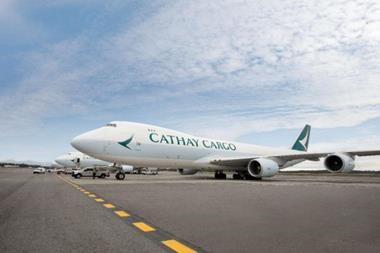
Source: Shutterstock
After reporting improving volumes and profitability in the fourth quarter, forwarders are facing a volatile start to 2025.
“We are in a very volatile world,” DHL Group chief executive Tobias Meyer told analysts in March.
Indeed, a new US administration inaugurated on 20 January, has already turned global trade upside down through the addition of new tariffs and threats to increase or implement additional duties.
Shippers are left unsure from one day to the next what tariffs are real and what are not.
Enter the freight forwarder for assistance.
“We have started with customer advisory calls in the US, leveraging our customs team. In the first call, we had close to 2,000 registrations. So, you see there is a lot of demand coming towards us when it comes to customs consultancy services,” Kuehne+Nagel chief executive Stefan Paul told analysts earlier in March.
It’s likely most freight forwarders will benefit from consultancy services for the foreseeable future as shippers manoeuvre through volatile markets - weighing their options between air and ocean freight services, new sourcing locations, customs and regulatory changes and more.
Expeditors International of Washington prepared for anticipated changes by adding employees in certain divisions.
“Given the growth in air and ocean shipments, increased customs declarations and other business activity, we carefully added headcount in certain important areas during the quarter,” Expeditors’ chief financial officer, Bradley Powell noted in the company’s fourth-quarter earnings announcement last month.
Other forwarders such as DHL are turning their attention to other geographic regions.
“Our geographical footprint is very much tilted to high-growth geographies and these geographies are currently not impacted as much from trade barriers, especially the new trade policy of the US administration,” Meyer told analysts.
“We have a higher market share in those fast-growing geographies, and that’s where we will continue to focus with our geographic tailwind programme, where we highlight several countries that have both strong GDP growth, but also strong trade growth, and we aim to solidify and grow our position, especially in those markets.”
However, as forwarders prepare for a year of change and upheaval in global trade, first-quarter results will likely show forwarders benefiting from the strengthening of demand leading up to the Lunar New Year in late January and frontloading of cargo ahead of potential tariff announcements.
Forwarders may also continue to benefit from frontloading through to the end of the quarter, ahead of 2 April when US reciprocal tariffs go into effect.
Meanwhile, de minimis and the Red Sea crisis remain toss-ups for the freight forwarding market.
The US administration’s change of mind to exclude de minimis in tariffs on China several days after the tariff went into effect in February came about because of 5m more shipments that entered the US during this period requiring customs clearance and leading to bottlenecks.
Tariff opportunity
DHL’s chief executive views this as an opportunity but it could mean extra costs for other forwarders if situations like this continue to randomly occur.
The Red Sea crisis, now in its second year, is another toss-up. Renewed violence between the US and the Houthis in Yemen and Israel’s recent attacks on Gaza have brought a sudden end to the short-lived calm in the Red Sea during the Gaza ceasefire.
As such, ocean freight capacity will continue to be restricted on routes that utilise the quicker Red Sea route and will negatively impact airfreight capacity which is already constrained due to e-commerce volumes.
According to investment group Jefferies, market conditions for 2025 indicate a preference for airfreight over seafreight because of its ability to adapt more swiftly to market conditions than ocean freight.
But that does not mean shippers should abandon ocean freight. Instead, shippers should have access to both modes of transportation and use each based on strategic goals and initiatives.
Ensuring adequate capacity at reasonable rates will be a competitive advantage among forwarders.
This is typically a basic given for using freight forwarders but as the world likely turns away from the US as a major trading partner, those forwarders with expertise in other parts of the world will be in demand.
As we prepare to close the book on the first quarter, DSV expects to officially complete its acquisition of DB Schenker in the second quarter when it anticipates receiving the final three approvals from government regulators, including those from the EU and the US.
Once approved, DSV will become the largest freight forwarder and will benefit from DB Schenker’s reach into new geographic regions and its logistics expertise.
For the rest of the forwarding market, keeping up with DSV may be a difficult task and could result in market consolidation this year.
In the meantime, now that the US has shared with the world what its trade plans are, shippers will rely on forwarders to guide them through what’s expected to be a year of vast changes in global trade.













